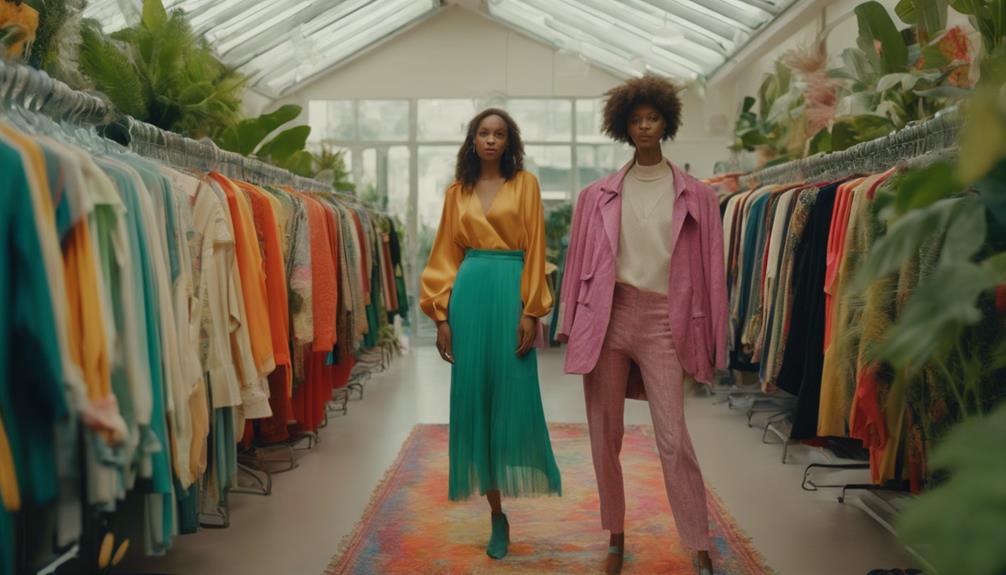Sustainable fashion involves making choices that prioritize both the environment and social responsibility when it comes to clothing. This includes reducing waste, utilizing eco-friendly materials, and supporting ethical brands. By practicing things like recycling and buying secondhand, individuals can help decrease the fashion industry’s large carbon footprint. Fast fashion is a major contributor to waste and pollution, but sustainable fashion is working to change that narrative. It’s not just a passing trend, it’s a movement towards a more responsible industry. Stay tuned to learn how you can create a sustainable wardrobe and make a positive impact on the planet.
Key Takeaways
- Sustainable fashion prioritizes environmental and social responsibility, focusing on reducing waste and minimizing carbon footprints in the clothing industry.
- Key principles include transparency in supply chains, use of eco-friendly materials, and promotion of circular fashion through recycling and upcycling.
- Fast fashion is a major contributor to global greenhouse gas emissions and waste, with 60% of clothing discarded within a year.
- Consumer responsibility plays a crucial role, as mindful purchasing and supporting ethical brands can significantly reduce fashion's environmental impact.
Understanding Sustainable Fashion
Sustainable fashion focuses on creating clothing that meets today's needs without jeopardizing future generations, emphasizing ethical practices and minimizing environmental impact. As you explore this movement, you'll find that it's not just about the clothes you wear but also about how they're made. Sustainable fashion champions the use of renewable resources and seeks to reduce the carbon footprint associated with the entire supply chain.
By advocating for ethical labor practices, it guarantees that garment workers receive fair wages and work under humane conditions. This focus on ethical standards fosters a more responsible industry, where people are prioritized alongside profits. Did you know that just extending the lifespan of your clothing by nine months can lower its environmental impact by up to 30%? This highlights the importance of making conscious choices.
Furthermore, sustainable fashion addresses the alarming statistic that less than 1% of clothing materials are recycled, promoting recycling and upcycling as key strategies to close the loop in the fashion world. Embracing sustainable fashion means you're not just making a statement about style; you're also contributing to a healthier planet and a fairer industry for everyone involved.
The Reality of Fashion Waste
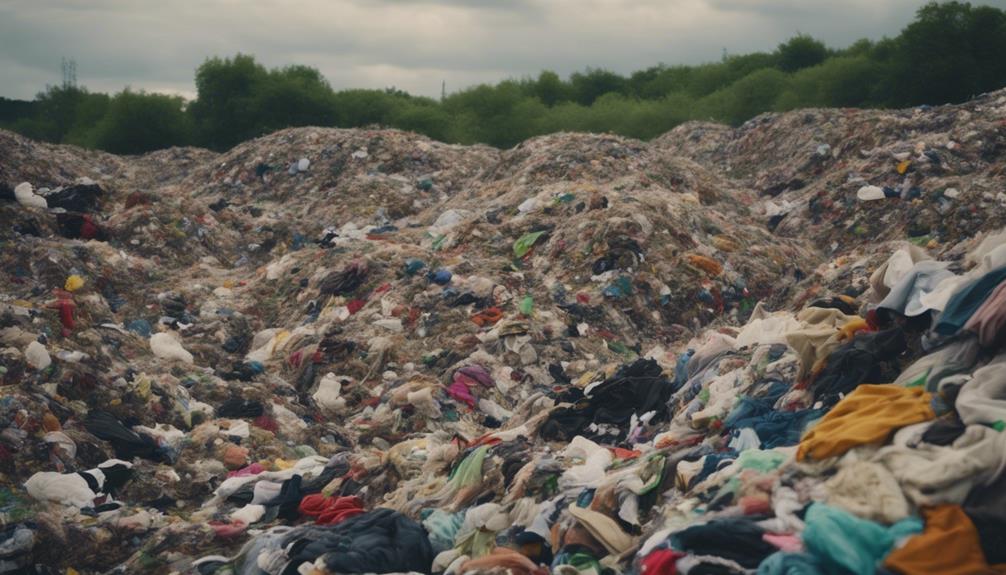
Fashion waste is a staggering issue, with the apparel and footwear industries contributing 8-10% of global greenhouse gas emissions and generating millions of tons of waste each year. You mightn't realize how quickly clothing becomes waste; approximately 60% of items end up in landfills or incinerators within just one year of purchase. This contributes to the alarming projection of 148 million tons of fashion waste by 2030, further exacerbating environmental degradation.
To understand the impact of fashion waste, consider these facts:
- Less than 1% of clothing materials are recycled.
- The fashion industry uses 20% of global wastewater.
- An annual loss of $100 billion in wasted resources occurs due to discarded clothing.
Myths About Sustainable Practices
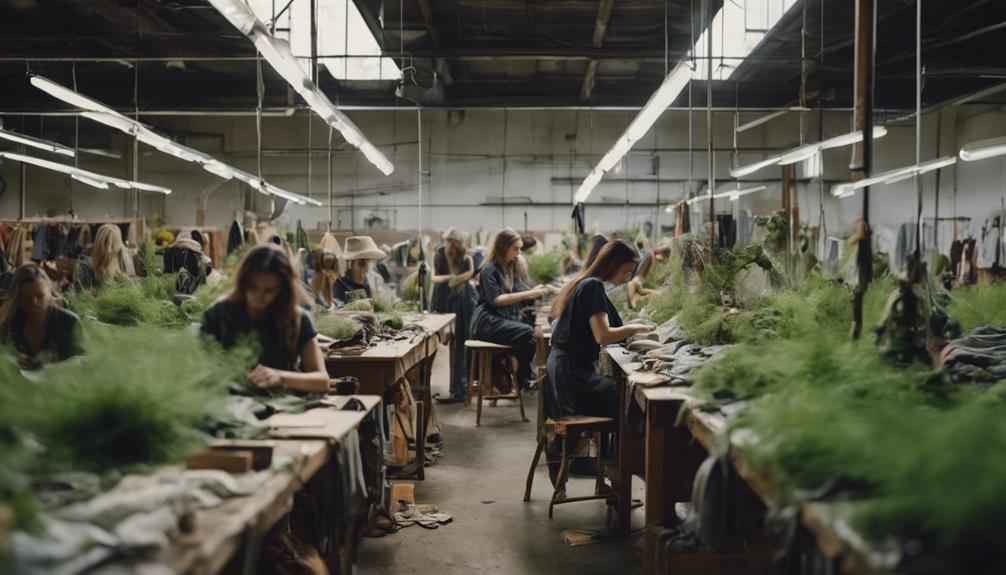
Understanding the reality of fashion waste sets the stage for addressing common myths about sustainable practices that can mislead consumers. You might think buying from eco-conscious brands is enough, but the best way to minimize your impact is to buy less and utilize your current wardrobe.
Here's a breakdown of some prevalent myths:
| Myth | Reality | Impact |
|---|---|---|
| Buying eco-friendly = sustainable | Reducing consumption is key | Less waste generated |
| Luxury fashion is always sustainable | High emissions from luxury events | Contributes to carbon footprint |
| Expensive garments guarantee fair labor | Many use the same factories as fast fashion | Worker exploitation remains prevalent |
| Donating clothes is always good | Most items end up in landfills or overseas | Harms local markets |
| Brands claiming sustainability are honest | Many engage in greenwashing | Misleading marketing practices |
These myths can cloud your understanding of what truly constitutes sustainable and ethical fashion. Be aware of greenwashing tactics and make informed choices to genuinely support ethical practices in the industry.
Environmental Impact of Fast Fashion
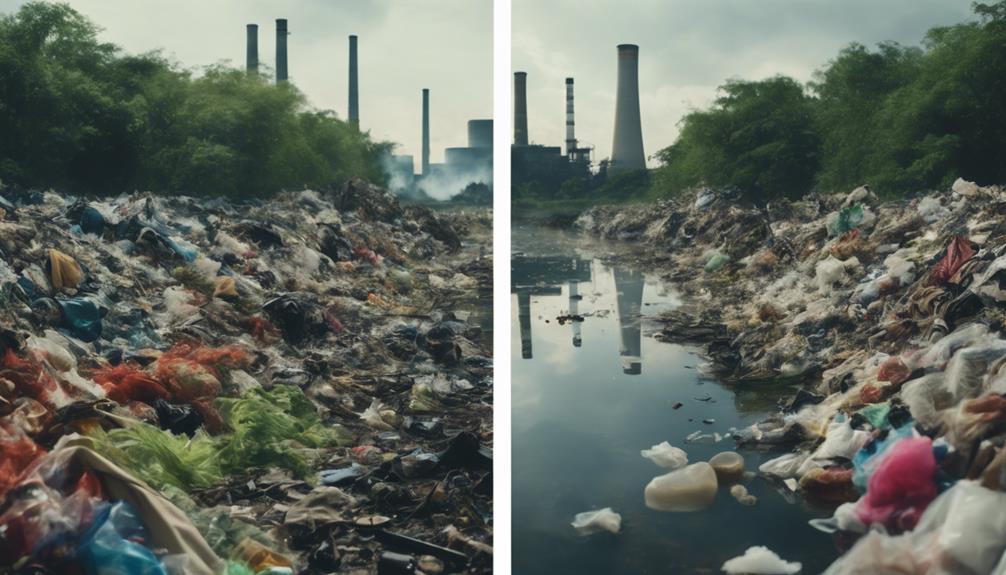
Fast fashion's environmental impact is staggering, with the industry generating a massive amount of waste and contributing considerably to greenhouse gas emissions.
You might be shocked to learn that 60% of clothing is tossed within a year of purchase, leading to overflowing landfills.
Plus, the resources required for production are being depleted at an alarming rate, raising serious concerns about sustainability.
Waste Generation Statistics
The apparel and footwear industries create a staggering 8% of global greenhouse gas emissions, highlighting their significant role in climate change. However, the real crisis lies in waste generation. Fast fashion's rapid production and consumption lead to a shocking statistic: 60% of clothing items are discarded in landfills or incinerators within just one year of purchase. This alarming trend not only contributes to overflowing landfills but also diminishes the value of textiles.
By 2030, fashion waste is projected to rise to 148 million tons, underscoring the urgent need for consumers to support sustainable brands.
Here are some key points to reflect on:
- Clothing utilization has decreased by 36% over the past 15 years.
- Less than 1% of clothing materials are recycled, resulting in significant financial loss.
- The fast fashion industry encourages a cycle of overconsumption and waste.
Greenhouse Gas Emissions
How can the fashion industry, responsible for up to 10% of global greenhouse gas emissions, continue to thrive while contributing so considerably to climate change? The impact on the planet is staggering, with apparel and footwear production alone emitting around 1.2 billion tonnes of CO2 annually—equivalent to the combined emissions of France, Germany, and the UK. If trends don't change, by 2050, the fashion sector could consume 26% of the global carbon budget, worsening the climate crisis.
Fast fashion's production processes typically involve high energy consumption and the use of non-renewable resources, which leads to increased greenhouse gas emissions. However, there's hope. Sustainable brands are stepping up, embracing circular economy principles and responsible sourcing. If the industry shifts towards these practices, it could potentially reduce emissions by 30%.
As a consumer, you can support these sustainable brands and encourage change. By making informed choices, you'll contribute to a collective effort to mitigate the fashion industry's environmental impact. It's time to rethink your wardrobe and choose options that prioritize the planet's health, helping to create a more sustainable future.
Resource Depletion Effects
Resource depletion is a pressing issue in the fashion industry, driven by unsustainable production practices and excessive consumption patterns. Fast fashion's relentless pursuit of trends leads to overproduction and waste, putting immense pressure on our planet's resources. You mightn't realize how your clothing choices contribute to this problem.
Consider these alarming facts:
- The fashion industry accounts for 8-10% of global greenhouse gas emissions, intensifying climate change.
- Apparel and footwear production uses around 93 billion cubic meters of water annually, enough to sustain 5 million people for a year.
- Approximately 60% of clothing ends up in landfills or incinerators within a year, exacerbating resource depletion and pollution.
Innovations in Sustainable Fashion

Innovative solutions are transforming sustainable fashion, turning waste into stylish, eco-friendly garments that reflect a commitment to the planet. Brands like Patagonia lead the way with innovations such as creating polyester fleece from recycled plastic bottles, demonstrating how you can repurpose waste materials into usable fabrics.
As the fashion industry produces 20% of global wastewater, companies are exploring eco-friendly production methods that minimize water usage and pollution, ensuring a lesser environmental impact.
Textile technology advancements, including lab-grown materials and advanced recycling methods, aim to close the loop on garment production and reduce reliance on virgin materials. You'll notice sustainable fashion brands increasingly adopting circular economy principles, focusing on designing garments for longevity, repairability, and recyclability. This approach not only reduces waste but also encourages a more thoughtful relationship with your clothing.
Moreover, technological advancements like blockchain enhance transparency in the supply chain, allowing you to track the origins and environmental impact of your clothing. These innovations signal a shift toward a more sustainable and responsible fashion industry, where your choices can contribute to a healthier planet and a more ethical future.
Consumer Responsibility in Fashion
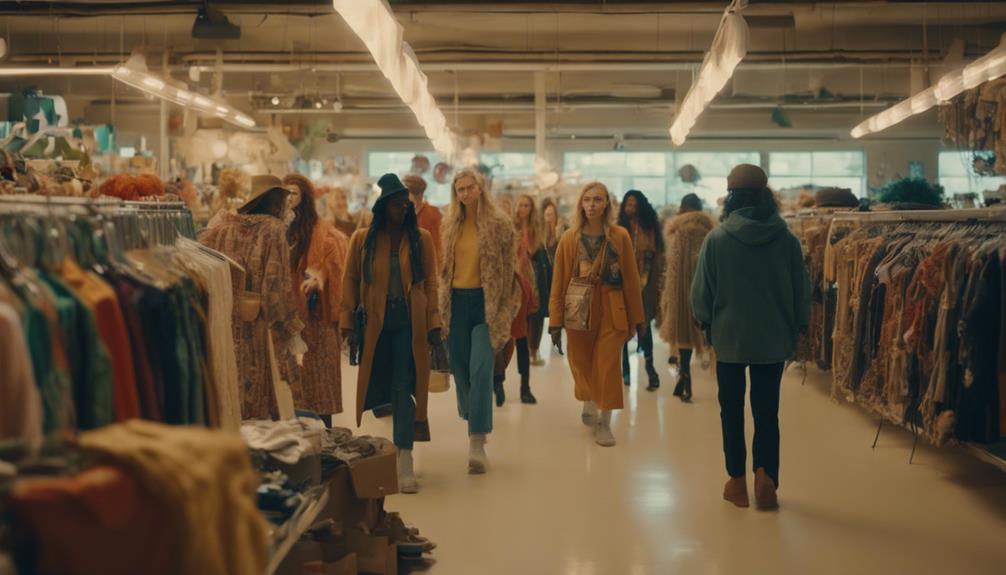
You can make a real impact in the fashion industry through mindful purchasing choices.
By supporting ethical brands and embracing secondhand options, you help promote sustainability and reduce waste.
Your decisions as a consumer matter, so let's explore how you can take responsibility for your fashion footprint.
Mindful Purchasing Choices
Mindful purchasing choices can greatly lessen your fashion footprint while promoting sustainability in an industry that heavily impacts the environment. By making conscious decisions, you can support the eco-friendly movement and drive change.
Here are some practical steps you can take:
- Prioritize shopping at sustainable brands that focus on ethical and sustainable practices.
- Explore thrift stores for unique, second-hand pieces while reducing waste.
- Extend the life of your existing wardrobe through mending and alterations, as even a nine-month extension can cut environmental impact by 30%.
Supporting Ethical Brands
Supporting ethical brands plays an essential role in transforming the fashion industry and encouraging responsible consumer behavior. When you choose to support sustainable and ethical brands, you're contributing to a positive shift in how garments are produced. Approximately 66% of consumers are willing to pay more for sustainable products, signaling a growing demand for responsible practices within the industry.
Many ethical brands prioritize transparency in their supply chains, allowing you to understand the labor practices and sourcing of materials involved in making your clothes. This transparency fosters trust, making it easier for you to make informed purchasing decisions. The Clean Clothes Campaign reveals that labor makes up only 3% of the total retail cost for mass-produced garments. By opting for ethical brands, even a small price increase can lead to better wages for workers.
Utilizing resources like Good On You helps you evaluate brands based on their impact on people, the planet, and animals. Additionally, by advocating for policy changes like The FABRIC Act, you empower yourself and others to demand corporate accountability and sustainable practices, ultimately driving the industry toward a more ethical future.
Embracing Secondhand Options
Choosing to embrace secondhand options not only complements your support for ethical brands but also greatly reduces the environmental impact of the fashion industry.
By shopping in the secondhand market, you actively participate in a circular economy, where garments are reused instead of thrown away. This practice helps divert textiles from landfills, combating the staggering amounts of fashion waste projected to reach 148 million tons by 2030.
Here are some benefits of shopping secondhand:
- Environmental Impact: Reduces carbon emissions linked to new clothing production.
- Cost-Effective: You can find high-quality items at a fraction of the original price.
- Unique Finds: Thrift shops often carry one-of-a-kind pieces that add character to your wardrobe.
The Role of Regulations

Regulations play a crucial role in holding fashion companies accountable for their environmental impacts, pushing them toward more sustainable practices. Without effective regulations, many companies might ignore their social impact and environmental responsibilities, perpetuating harmful practices in the supply chain. Strong legislative frameworks can guarantee transparency, prompting brands to adopt ethical labor practices and sustainable sourcing of materials.
Here's a quick overview of the role of regulations in sustainable fashion:
| Aspect | Importance | Current Challenges |
|---|---|---|
| Accountability | Holds companies responsible | Many regulations lack enforcement |
| Transparency | Guarantees ethical supply chains | Limited visibility in sourcing |
| Collaboration | Promotes industry standards | Varying approaches among stakeholders |
Governments can enforce regulations that require companies to internalize the costs of their negative environmental impacts. Collaborative efforts between governments and industry stakeholders can establish effective standards, driving genuine sustainability. Ultimately, strong regulations not only foster responsible production practices but also contribute to a more socially and environmentally conscious fashion industry.
Future Trends in Sustainability

As regulations push companies toward accountability, the future of sustainability in fashion looks promising, driven by innovation and consumer demand for eco-friendly practices.
You'll likely see a significant shift in how brands operate, focusing on sustainable fashion that prioritizes the planet.
Here are some future trends to watch:
- Growth of the Circular Economy: More brands will adopt recycling, upcycling, and rental options to extend garment lifecycles.
- Innovative Textile Technologies: Expect lab-grown materials and improved recycling methods to reduce the environmental footprint of fashion.
- Increased Legislative Changes: Governments will implement stricter regulations to hold brands accountable for their environmental and labor practices.
With a projected growth rate of 9.7% in the sustainable fashion market, it's clear that consumer preferences are shifting toward products that reflect their values.
As you navigate your choices, stay informed about these trends, as they'll shape the future of your wardrobe and the fashion industry as a whole.
Building a Sustainable Wardrobe

Creating a sustainable wardrobe means prioritizing quality pieces that last, helping you reduce your environmental impact greatly. By focusing on quality over quantity, you can extend the lifespan of your clothing. Just nine extra months can cut your environmental footprint by up to 30%.
Adopting a minimalist wardrobe approach encourages you to choose versatile items you truly love, making it easier to resist the allure of fast fashion.
Engaging in clothing swaps or shopping second-hand can also greatly reduce waste and consumption. Remember, only 10-20% of donated items actually sell in charity shops, so buying second-hand helps keep clothing in circulation.
Instead of discarding damaged garments, consider repairing them. These small fixes can prolong the life of your clothes and contribute to sustainable fashion.
Educating yourself about clothing lifecycles and the true costs of production is essential. This knowledge empowers you to make responsible purchasing decisions, combat greenwashing, and support brands that are genuinely committed to sustainability.
Frequently Asked Questions
What Is Sustainable Fashion in Simple Terms?
Sustainable fashion means choosing clothes made with eco-friendly materials and ethical practices. It focuses on reducing waste, promoting recycling, and ensuring fair labor, so you can make a positive impact on the planet through your wardrobe.
Do People Really Care About Sustainable Fashion?
Yes, people really care about sustainable fashion. You'll find that many prioritize eco-friendly practices in their shopping, willing to pay more for ethical products. Awareness is growing, but understanding true sustainability is still essential.
What Is the Problem With Sustainable Fashion?
Sustainable fashion often resembles a mirage, promising change yet delivering little. You'll find that despite claims, significant waste and environmental harm persist, revealing a gap between perception and reality that needs urgent addressing. Many brands and consumers are eager to jump on the sustainable fashion trends bandwagon, but it’s important to question the authenticity of these claims and dig deeper into the supply chain and production methods. True sustainability goes beyond just using organic materials or recycling old garments – it requires a holistic approach that considers the entire lifecycle of a piece of clothing, from sourcing to disposal. Only when we shift our focus to real, meaningful change can we start to bridge the gap between perception and reality in the fashion industry.
What Is the Paradox of Sustainable Fashion?
You'll find the paradox of sustainable fashion lies in its marketing versus reality. While you might choose eco-friendly brands, continuing fast fashion habits ultimately undermines your efforts, making true sustainability elusive without significant behavioral changes.
Conclusion
In the tapestry of fashion, every choice you make weaves a thread of sustainability.
By embracing eco-friendly practices and supporting responsible brands, you can transform your wardrobe into a beacon of hope for the planet.
Remember, your purchasing power holds the weight of change—don't underestimate its impact.
As you step into the future, let your style reflect your values, crafting a world where fashion flourishes without costing the Earth.
Together, let's stitch a brighter tomorrow!





